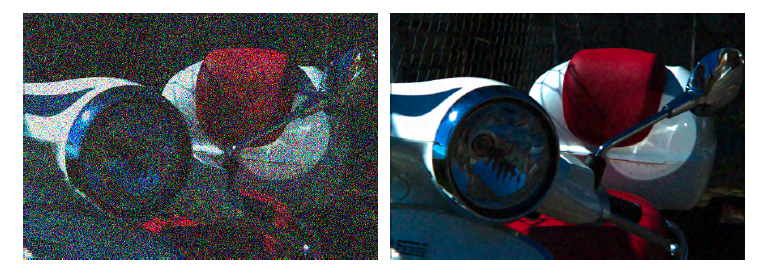Section: New Results
Algorithms for inverse problems in visual data processing
Inpainting, view synthesis, super-resolution
View synthesis in light fields and stereo set-ups
Participants : Simon Evain, Christine Guillemot, Matthieu Hog, Xiaoran Jiang.
We have developed a lightweight convolutional neural network architecture able to perform view synthesis with occlusion handling in a stereo context, from one single, unlabelled and unannotated image, beyond state-of-the-art performance and with only a small amount of data required for training. In particular, it is able, at training and at test time, to estimate the disparity map corresponding to the problem at hand, and to evaluate a confidence in its prediction when using said disparity map for the synthesis. Knowing this confidence measure, it is then able to refine the value of the pixels wrongly estimated, with a refinement network component. The end result is a prediction built from a geometrical analysis of the scene, and completed in wrongly predicted areas by occlusion handling. Since 3D scene information is extracted in the course of the analysis, multiple new views can then be generated by interpolation.
Finally, in collaboration with Technicolor (N. Sabater and M. Hog), we have explored a novel way using recurrent neural networks to solve the problem of view synthesis in light fields. In particular, we proposed a novel solution using Long Short Term Memory Networks on a plane sweep volume. The approach has the advantage of having very few parameters and can be run on arbitrary sequence length. We have shown that the approach yields results that are competitive with the state of the art for dense light fields. Experimental results also show promising results when run on wider baselines.
Light field inpainting and restoration
Participants : Pierre Allain, Christine Guillemot, Laurent Guillo.
With the increasing popularity of computational photography brought by light field, simple and intuitive editing of light field images is becoming a feature of high interest for users. Light field editing can be combined with the traditional refocusing feature, allowing a user to include or remove objects from the scene, change its color, its contrast or other features. A simple approach for editing a light field image can be obtained with an edit propagation, where first a particular subaperture view is edited (most likely the center one) and then a coherent propagation of this edit is performed through the other views. This problem is particularly challenging for the task of inpainting, as the disparity field is unknown under the occluding mask. We have developed a method that is computationally fast while giving coherent disparity in the masked region, allowing us to inpaint a light field of 81 views in a few seconds [10].
We have also developed a novel light field denoising algorithm using a vector-valued regularization operating in the 4D ray space. More precisely, the method performs a PDE-based anisotropic diffusion along directions defined by local structures in the 4D ray space. It does not require prior estimation of disparity maps. The local structures in the 4D light field are extracted using a 4D tensor structure. We use a diffusivity coefficient derived from the amount of local variations in the 4D space to control the smoothing along directions, surfaces, or volumes in the 4D ray space. The diffusivity coefficient is computed as a function of the 4 eigenvalues of the 4D structure tensor. Experimental results show that the proposed denoising algorithm performs well compared to state of the art methods, while keeping tractable complexity, even with high noise levels (see Fig.5).
|
High dynamic range light fields capture
Participant : Christine Guillemot.
In collaboration with Trinity College Dublin (Prof. A. Smolic, Dr. M. Le Pendu), we have proposed a method for capturing High Dynamic Range (HDR) light fields with dense viewpoint sampling. Analogously to the traditional HDR acquisition process, several light fields are captured at varying exposures with a plenoptic camera. The raw data are de-multiplexed to retrieve all light field viewpoints for each exposure. We then perform a soft detection of saturated pixels. Considering a matrix which concatenates all the vectorized views, we formulate the problem of recovering saturated areas as a Weighted Low Rank Approximation (WLRA) where the weights are defined from the soft saturation detection. The proposed WLRA method [18], extending the matrix completion algorithm of [7] to nonbinary weights, is shown to better handle the transition between the saturated and non-saturated areas. While the Truncated Nuclear Norm (TNN) minimization, traditionally used for single view HDR imaging, does not generalize to light fields, the proposed WLRA method successfully recovers the parallax in the over-exposed areas.



